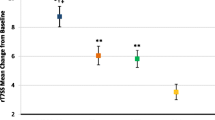Abstract
Objective: Data on intranasal corticosteroids suggest that individual product attributes may influence patient preference for therapy in allergic rhinitis. The study objective was to compare product sensory attributes and their impact upon patient preference for scent-free mometasone furoate nasal spray (MFNS) versus fluticasone propionate nasal spray (FPNS) in patients with symptomatic allergic rhinitis.
Methods: In a double-blind, crossover study, 100 patients were randomized to MFNS 200μg followed by FPNS 200μg, or vice versa. Patients rated the study drugs by completing an individual product sensory attributes questionnaire at the end of each period of drug administration. An overall sensory preference questionnaire was completed following crossover.
Results: A significantly greater number of patients preferred MFNS to FPNS (p < 0.05). MFNS was superior for a number of individual sensory attributes based on mean patient ratings: significantly fewer patients perceived scent/odor (immediately and 2 minutes after drug administration; p < 0.001), taste (immediately after drug administration; p = 0.002), and after-taste (2 minutes after drug administration; p = 0.007) with MFNS compared with FPNS. Similarly, product sensory attribute preference data demonstrated that twice the number of patients preferred MFNS to FPNS for scent/odor (p = 0.0005), immediate taste (p = 0.005), and after-taste (p = 0.005). Fifty-four percent of patients said they would choose a prescription for MFNS compared with 33% for FPNS (p = 0.03). In addition, 47% of patients would be more likely to comply (use daily as directed) with MFNS compared with 25% with FPNS (p = 0.03).
Conclusion: Several individual sensory attributes of MFNS were rated significantly superior to FPNS. Overall, based on the tested sensory attributes, patients preferred MFNS to FPNS therapy for the treatment of allergic rhinitis.







Similar content being viewed by others
Notes
1 The use of trade names is for product identification purposes only and does not imply endorsement.
References
D’Alonzo Jr GE. Scope and impact of allergic rhinitis. J Am Osteopath Assoc 2002; 102: S2–6
Bousquet J, Van Cauwenberge P, Bachert C, et al. Requirements for medications commonly used in the treatment of allergic rhinitis. European Academy of Allergy and Clinical Immunology (EAACI), Allergic Rhinitis and its Impact on Asthma (ARIA). Allergy 2003; 58: 192–7
Tripathi A, Patterson R. Impact of allergic rhinitis treatment on quality of life. Pharmacoeconomics 2001; 19(9): 891–9
Roper Public Affairs Group of NOP World. Impact of nasal congestion among allergic rhinitis sufferers. May–Jun 2004
Ferguson BJ. Influences of allergic rhinitis on sleep. Otolaryngol Head Neck Surg 2004; 130: 617–29
Skoner DP. Complications of allergic rhinitis. J Allergy Clin Immunol 2000; 105: S605–9
American Academy of Allergy, Asthma & Immunology, Inc. Allergic disorders: promoting best practice [online]. Available from URL: http://www.theal-lergyreport.org/reportindex.html [Accessed 2005; June]
Linneberg A, Henrik Nielsen N, Frolund L, et al. The link between allergic rhinitis and allergic asthma: a prospective population-based study. The Copenhagen Allergy Study. Allergy 2002; 57: 1048–52
Bachert C, El-Akkad T. Patient preferences and sensory comparisons of three intranasal corticosteroids for the treatment of allergic rhinitis. Ann Allergy Asthma Immunol 2002; 89: 292–7
Shah SR, Miller C, Pethick N, et al. Two multicenter, randomized, single-blind, single-dose, crossover studies of specific sensory attributes of budesonide aqueous nasal spray and fluticasone propionate nasal spray. Clin Ther 2003; 25: 2198–214
Meltzer EO, Hadley J, Blaiss M, et al. Development of questionnaires to measure patient preferences for intranasal corticosteroids in patients with allergic rhinitis. Otolaryngol Head Neck Surg 2005; 132: 197–207
Brannan MD, Herron JM, Affrime MB. Safety and tolerability of once-daily mometasone furoate aqueous nasal spray in children. Clin Ther 1997; 19: 1330–9
Hebert JR, Nolop K, Lutsky BN. Once-daily mometasone furoate aqueous nasal spray (Nasonex) in seasonal allergic rhinitis: an active- and placebo-controlled study. Allergy 1996; 51: 569–76
Mandl M, Nolop K, Lutsky BN. Comparison of once daily mometasone furoate (Nasonex) and fluticasone propionate aqueous nasal sprays for the treatment of perennial rhinitis: 194-079 study group. Ann Allergy Asthma Immunol 1997; 79: 370–8
Graft D, Aaronson D, Chervinsky P, et al. A placebo- and active-controlled randomized trial of prophylactic treatment of seasonal allergic rhinitis with mometasone furoate aqueous nasal spray. J Allergy Clin Immunol 1996; 98: 724–31
The European Agency for the Evaluation of Medicinal Products. ICH topic E6. Guideline for good clinical practice. 2002
Gart JJ. An exact test for comparing matched proportions in crossover designs. Biometrika 1969; 56: 75–80
Lachin JM. Biostatistical methods. John Wiley & Sons, New York; 2000
Trangsrud AJ, Whitaker AL, Small RE. Intranasal corticosteroids for allergic rhinitis. Pharmacotherapy 2002; 22: 1458–67
Gerson I, Green L, Fishken D. Patient preference and sensory comparisons of nasal spray allergy medications. J Sens Stud 1999; 14: 491–6
Acknowledgments
This study was supported by the Integrated Therapeutics Group, Inc. (a subsidiary of the Schering-Plough Corporation). Editorial assistance was provided by Thomson Gardiner-Caldwell London.
The author(s) certify that they have no affiliation with, or financial involvement in, any organization or entity with a direct financial interest in the subject matter or materials discussed in this manuscript (e.g. employment, consultancies, stock ownership, honoraria).
Author information
Authors and Affiliations
Rights and permissions
About this article
Cite this article
Meltzer, E.O., Bardelas, J., Goldsobel, A. et al. A Preference Evaluation Study Comparing the Sensory Attributes of Mometasone Furoate and Fluticasone Propionate Nasal Sprays by Patients with Allergic Rhinitis. Treat Respir Med 4, 289–296 (2005). https://doi.org/10.2165/00151829-200504040-00007
Published:
Issue Date:
DOI: https://doi.org/10.2165/00151829-200504040-00007




